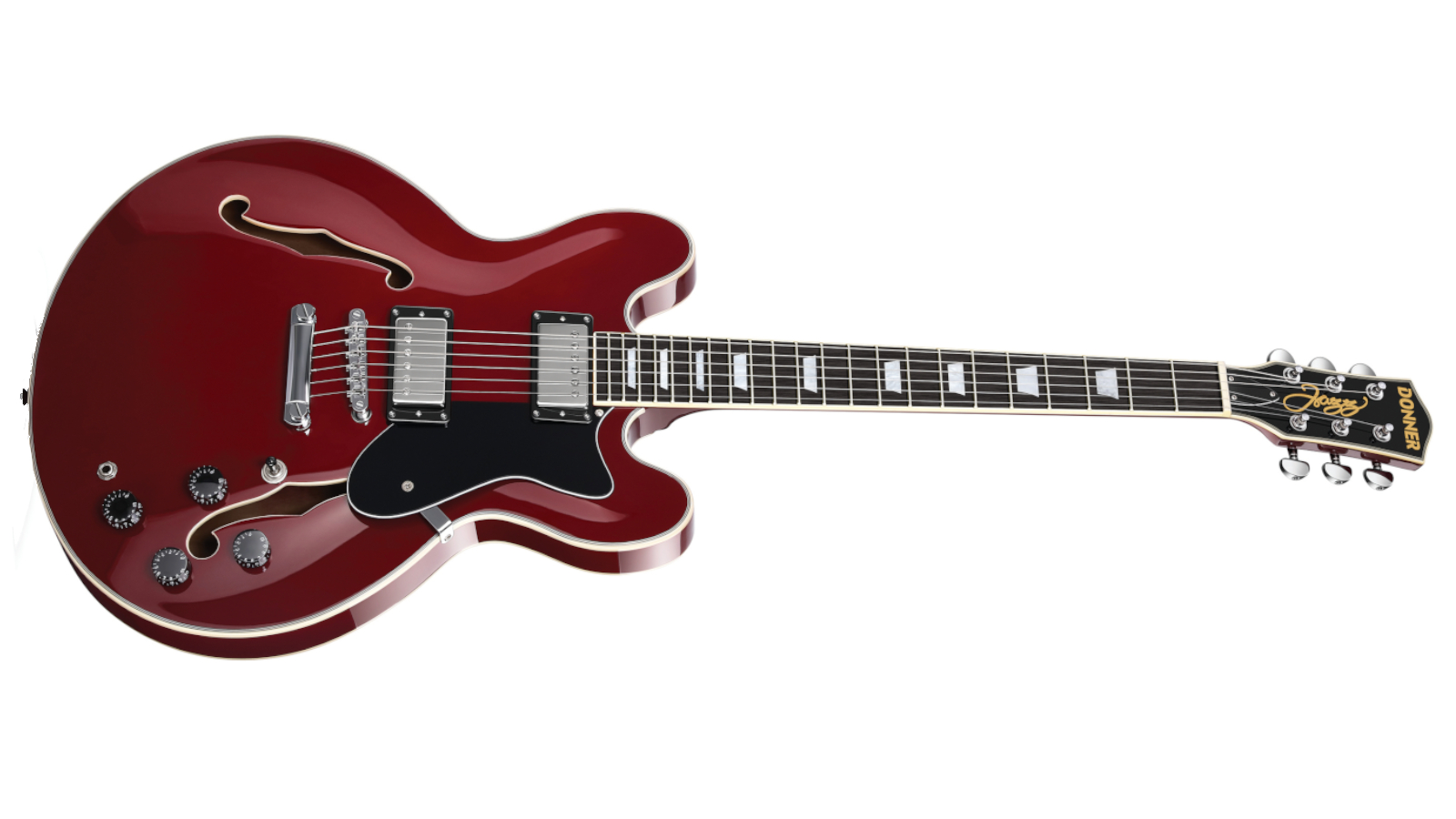GuitarPlayer Verdict
The DJP-1000 has a lot to offer those who seek a less-expensive route to the versatility, sweet look and great-playing feel of this classic semi-hollow
Pros
- +
A classic-looking guitar that’s well made
- +
Fun to play
- +
Affordable
Cons
- -
None
You can trust Guitar Player.
With its classic double-cutaway shape and semi-hollow construction, the DJP-1000 represents Donner’s take on one of the most successful electric guitars that Gibson launched in the late 1950s under president Ted McCarty.
The DJP-1000 stays essentially true to form by featuring a body made from laminated maple with a solid-maple center block and a glued-in neck carved from maple instead of mahogany.
It carries two humbucking pickups under nickel-plated covers, along with the standard configuration of two volume and two tone controls, and a three-way toggle switch for pickup selection.
To increase flexibility, both volumes have push-pull coil-split switches.

The DJP-1000 is a great looking guitar with its gloss-red finish (it’s also available in gloss black and sunburst) and a preponderance of white binding, which is all carefully done, revealing no slop in the miter joints, color bleed or unevenness in height where the binding meets the wood.
The multi-ply trim on the headstock face is flawless and the trapezoid inlays on the fingerboard are cleanly set without excess filler.
Very nice.
All the latest guitar news, interviews, lessons, reviews, deals and more, direct to your inbox!
Hardware consists of a Tune-o-matic–style bridge and stop tailpiece, and the headstock sports chrome-die-cast tuners with Grover-style half-round buttons.
The guitar was set up with very low action and tuneful intonation. I only needed to loosen the truss rod and raise the bridge a bit to eliminate some buzzing above the 10th position.

The frets are nicely shaped and given a light polish, and their ends are smoothly beveled. The nut is also evenly set and has no sharp corners.
The DJP’s sound is bright and fairly loud when strummed acoustically, and it sustains like a solid guitar thanks to the maple center block.
Plugged into a Fender Deluxe Reverb tube amp and a Boss Katana-50 MkII for higher-gain tones, the DJP-1000 delivered a good range of sounds.
The pickups have a balanced response and plenty of output, and my only slight issue is that they lack some of the juicy complexity and responsiveness to playing dynamics offered by the pickups on a Gibson Historic ES-335 used for comparison.

Considering the price difference, however, the DJP deserves kudos for offering clear neck-position sounds that are cool for blues and jazz, and bright bridge-pickup tones that rocked hard when fueled up with a Fulltone OCD or a TWA SH9 overdrive pedal. (I’d usually leave them on when using the Fender amp, and ride the guitar’s volumes to get dirtier or cleaner tones.)
They sounded especially great running in split-coil mode to make up for a drop in output when riffing on those crisp, funky sounds.
The DJP-1000 has a lot to offer those who seek a less-expensive route to the versatility, sweet look and great-playing feel of this classic semi-hollow.
With its good build quality and attention to detail, the DJP-1000 is a bang-for-buck champ that makes a great go-to gig guitar.
Specifications
- NUT: Synthetic bone, 1 11/16” wide
- NECK: Maple, rounded C shape
- FRETBOARD: Rosewood, 24 3/4” scale
- FRETS: 22 medium jumbo
- TUNERS: Die-cast, chrome
- BODY: Laminated maple back and sides, laminated-maple top
- BRIDGE: Tune-o-matic-style with stop tailpiece
- PICKUPS: Donner humbuckers with nickel covers
- CONTROLS: Volume and tone for each pickup, push-pull switching on volume pots for coil-split (outside coils), 3-way toggle
- FACTORY STRINGS: D’Addario .010–.046
- WEIGHT: 7.86 lbs (as tested)
- BUILT: China
Visit Donner for more information.

Art Thompson is Senior Editor of Guitar Player magazine. He has authored stories with numerous guitar greats including B.B. King, Prince and Scotty Moore and interviewed gear innovators such as Paul Reed Smith, Randall Smith and Gary Kramer. He also wrote the first book on vintage effects pedals, Stompbox. Art's busy performance schedule with three stylistically diverse groups provides ample opportunity to test-drive new guitars, amps and effects, many of which are featured in the pages of GP.

